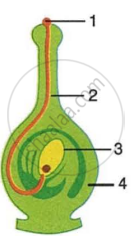Advertisements
Advertisements
प्रश्न
P and Q are two types of plants having weak stems which cannot stand upright on their own. The plants P and Q have organs R and S respectively which can grow towards any support which they happen to touch and wind around that support. It is observed that organ R originates from the leaves of the plant whereas organ S originates directly from the stem of the plant.
(a) What is (i) R, and (ii) S?
(b) What is the name of growth movement exhibited by the organs R and S?
(c) Name the stimulus involved in this case.
(d) State whether the behaviour of organs R and S is a tropic movement or a nastic movement.
(e) Name one plant like P and another plant like Q.
उत्तर
(a) (i) R is a leaf tendril and (ii) S is a stem tendril.
(b) The growth movement exhibited by R and S is thigmotropism.
(c) The stimulus involved is touch or contact with other objects.
(d) The behaviour of R and S is a tropic movement.
(e) Pea plant is an example of plant type P, whereas bitter gourd plant is an example of the type Q.
APPEARS IN
संबंधित प्रश्न
What is the stimulus in phototropism?
What is a plant hormone? Name four plant hormones. State one function of each.
Give one example of the movement of a plant part which is caused by the loss of water (or migration of water).
Name the plant part which bends towards light but away from the force of gravity.
The movement of a shoot towards light is:
While conducting experiments to study the effect of various stimuli on the plants, it was observed that the roots of a plant X grow and bend towards two stimuli A and B but bend away from a third stimulus C. The stem of the plant X, however, bends away from stimuli A and B but bends towards the stimulus C. The stimulus B is known to act on the roots due to too much weight of the earth. Keeping these points in mind, answer the following question:
- What could stimulus A be?
- Name the stimulus B.
- What could stimulus C be?
- The branches of a fallen tree in a forest grow straight up in response to two stimuli. What could be these two stimuli out of A, B and C? Also name these two stimuli.
Chlorophyll differs from hemoglobin by the presence of its central molecule ______.
The Scientific term used to represent the bending of roots toward water is called geotropism.
What does a Mimosapudica plant do in response to touch? What is the phenomenon known as?
The diagram given alongside shows a type of tropism. Study the same and answer the questions that follow:

- Name and define the type of tropism shown in the diagram.
- Label the guidelines (1) to (4).
- Name two effective stimulants that help in the growth of part (2).
- Name two groups of plants where part (2) grows towards gametophyte with the help of the stimulants mentioned in (c).
